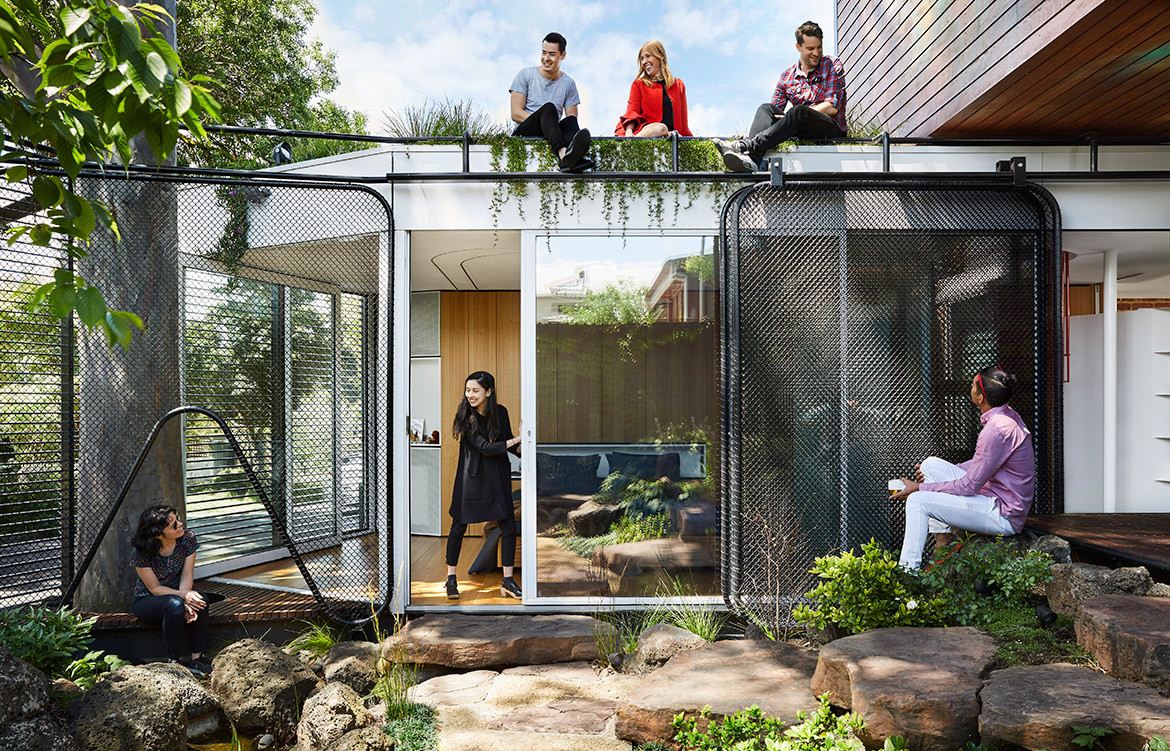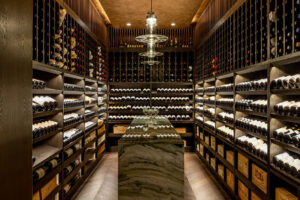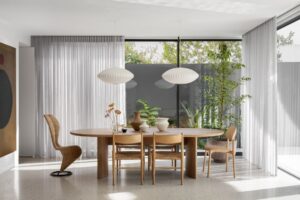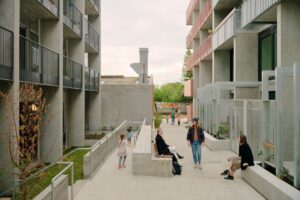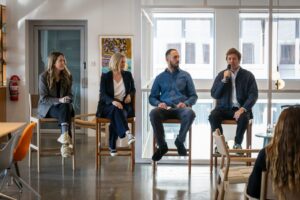2020 is not yet halfway through and it has already proven itself to be an eye-opening year. There is nothing quite like a global pandemic to inspire – or enforce – systemic overhaul. In the wake of emergency social reform, we’ve found ourselves in need of a crash-course: Virtual Collaboration For Dummies. On Wednesday, 3 June, as part of the Habitus Webinar Series, four of Australia’s most astute architecture and design industry contemporaries zoomed in (virtually speaking) on the topic of remote workplace culture and practicing collaboration from home.
Moderated by Habitus editor, Holly Cunneen, the expert panel comprised none other than Hayball principal, Donna Wheatley; Mim Design founder and principal, Miriam Fanning; Hassell design operations lead, Tristrim Cummings; and SP01 co-founder and creative director, Matt Lorrain. When it comes to the business of design and what effective virtual collaboration looks like, Donna, Mim, Tristrim and Matt represent four undoubtedly diverse yet entirely pertinent perspectives. The insights and observations of these four Australian architecture and design professionals, as seen from their unique vantage points, culminate in the following industry truths.
“Now that people have become comfortable with remote ways of working and experienced the benefits of working from home, we would never want to take that away from them,” says Donna.
Virtual Collaboration, In Reality
In Hassell’s experience, the shift to working remotely has brought about more authentic connections says Tristrim. This applies to the perceived removal of walls between internationally spread studios, as well as the newly opened window into clients’ worlds. That window goes both ways, as highlighted by Mim who feels the more open and frequent communications offers clients a new level of insight into the design process, cultivating a deeper sense of respect as a result.
In terms of workplace culture, Donna shares that two of Hayball’s three studios have reported to feel more connected to the business since the protocols surrounding COVID came into play. Its worth noting that this is more than merely a happy coincidence. “We put strategies in place to ensure a sense of connectivity while working from home – but we had no idea how powerful they would turn out to be,” the workplace design strategist says.
So, now we know: we have nothing to fear of virtual collaboration. A remote workforce does not need to mean an inevitable breakdown in communications – not with clients; not with external collaborators; nor amongst internal teams. That said, there are three fundamental learnings distilled from the dialogue of our industry’s experts that resound as pertinent to enabling remote design teams to work and collaborate effectively from home. Firstly, no communication method suits all; secondly, purpose and preparation make perfect; and finally, in the spirit of evolution, we must be agile and open-minded to survive.
No Communication Method Suits All
The fickle nature of individual communication preferences is hardly unique to working remotely. Some like a spontaneous catch up – be it over the phone or in person – while others feel more comfortable interacting via channels that capture things in writing, such as email or the plethora of chat/comment mechanisms offered by the digital tools at hand. This is as true as ever.
The shift to working remotely has brought about more authentic connections with clients, as well as within internal teams, for Hassell.
“You can’t force a medium on anyone,” says Matt, stating a fact with which Tristrim, Donna and Mim each decidedly attest. Tristrim’s wise advice on this matter is to find what works best for each client, external collaborator and internal team on a project-by-project basis. “Finding the right mode and means is so important,” he says. Doing so has the opportunity to add exponential value to internal and external relationships alike, as evidenced in anecdotes from each of the webinar panel members.
The layer of complexity added in the context of virtual collaboration is the monotony of interacting digitally. “2020 is going to be the year of digital fatigue,” Tristrim warns. While there is no surefire antidote to this problem, Tristrim’s suggestion is to try, however you might, to break up the repetitiousness of your digital interactions. “It can be as simple as getting on your phone, instead of your PC, and going for a walk while you talk,” he says.
Purpose (And Planning) Makes Perfect
“It can be charming to hash out an agenda on the fly at the beginning of a meeting in person, but no one appreciates that lack of preparation in virtual contexts,” Donna shares as a matter of fact. Mim, Tristrim and Matt all echoed that only good can come from a pre-meeting meeting. What are the meeting objectives? What’s on the agenda? Who will bring what to the table? The answers to these questions are professed to be key to facilitating truly valuable virtual collaboration.
“Since we began working from home we’ve had to reduce the size of our workshops,” shares Mim. Her eponymous studio has always been a highly communicative practice, to which collaborative workshops are integral to design. Though idealistically she avows that an open door is best policy for design workshops, restricting such sessions to only those directly involved in a project has been a necessary sacrifice in the quest to ensure collaboration from home is focused and effective.
Company-wide calendar transparency helps the Hayball team to know who’s working on what and when, optimising opportunities for virtual collaboration.
The value of having a clearly defined purpose and a plan of attack is not only relevant for meetings, but for individual time management too. Time-blocking is an essential ingredient for enabling effective collaboration from home, Donna, Mim, Tristrim and Matt couldn’t agree more. “I organise my days into three time-blocks: a few hours in the morning; a few hours after lunch; then maybe a couple of hours break before coming back online at night,” says Matt, describing the day structure that has helped him to find balance while working from home.
Company-wide calendar transparency helps the team at Hayball to know who’s working on what and when. This works to optimise opportunities for virtual collaboration between remote design teams Donna shares. “If I can see that a team member has blocked out a certain period of time to work on a project that we share, then I can coordinate to work with or talk to them about that project at that time,” she says. Such visibility also prevents out-of-context interruptions as well as days of back-to-back meetings, by enabling people to block out down time in between tasks and/or meetings to cognitively switch contexts.
Long Live The Agile Design Practise
“Now that people have become comfortable with remote ways of working and experienced the benefits of working from home, we would never want to take that away from them,” says Donna. As a business Hayball is taking a ‘trial and error’ type approach to establishing how things will work moving forward – embracing whatever proves to add value and leaving behind the rest. One thing in particular Hayball is interested in incorporating into its post-COVID world is more flexible working hours for all.
Such an agile and open-minded approach serves as an exemplar for design businesses, one and all, moving forward. As life goes on and we learn to mitigate the systemic reforms that keep the threat of COVID at bay, ways of working remain at the mercy of the great unknown. But then again, of all the lessons to be distilled from the disrupt caused to design practises by the great pandemic of the 21st century, there is one most enlightening. That being the juxtaposition between our previous preconceptions surrounding remote ways of working, and our actual experiences of working from home. How much longer would our unfounded assumptions have held us back from realising the benefits that we now do, if COVID-19 had never occurred?
Embrace whatever proves to add value and leave behind the rest.
“I think that maybe this was a lesson that we had to learn,” says Matt, with specific acknowledgement of the environmental and economic benefits of practicing collaboration from home. As co-founder and creative director of SP01, a typical year would see Matt travel to Europe and/or the United States on business at least three times. At the time of the webinar, SP01 was preparing for its first significant prototype showcase to be orchestrated virtually. If all goes off without a hitch, it could change everything for the furniture design business. “The more we adapt to video conferencing, the more natural it becomes and the less need there is for travel,” Matt notes that, in the grand scheme of things, the resulting reduced energy consumption and localised operational footprint of business would be in everyone’s best interests – a point with which we wholeheartedly agree.
Featured image: Kiah House by Austin Maynard Architects. Photographed by Tess Kelly.


